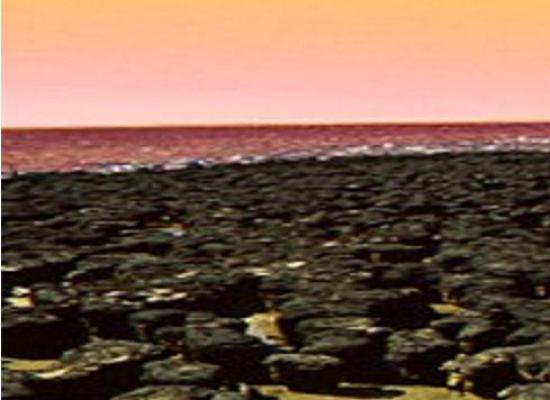BY LETTER
Stromatolite
 Image from M. Alan Kazlev | |
| Stromatolites on the eoarean world Laetona (outer Cygexpa Volume) | |
Colonial aquatic, littoral, or semi-aquatic prokaryote or prokaryotoid, prokaryote-equivalant life form, one of the most common forms of macroscopic life in the galaxy. The colonies form large raised mounds, pillars, or pillows, with an outer layer of photosynthetic organisms, and concentric inner shells of deposited material.
The Terragen versions were colonies of blue-green algae that appeared along shorelines and in shallow water. Most abundant from about 3.5 to 2 billion years ago. Stromatolites do best in water-rich temperate to warm low-diversity carbon-based ecosystems such as are common in EuVenusian, EuGaian, and EuArean type planets.
Related Articles
- Coral - Text by M. Alan Kazlev and Stephen Inniss
Terragen marine metazoan animals, class Anthozoa, phylum Cnidaria. Though some are solitary, a typical coral is a colony of genetically identical polyps, each of which secretes calcium carbonate at its base to create a common skeleton with a characteristic structure. They are often brightly colored when alive, but after death of the polyp the color fades and becomes a bleached white. The best known and most numerous types of corals derive much of their sustenance from symbiotic photosynthetic algae. Because of this these are limited to regions of sunny shallow water and low nutrient flow, where bright light reaches the ocean floor. Such corals are an important element of many phototrophic tropical ocean biospheres. - Coral Reef - Text by M. Alan Kazlev
Aquatic Terragen community of organisms, wave-resistant biological structure resulting from cementation processes and the skeletal construction of hermatypic corals, calcareous algae, and other calcium carbonate-secreting organisms. Forms a rich habitat for many types of marine organisms. Coral reefs are popular in many large Terragen habitats with a strong aquatic component and tropical or semi-tropical climate. Some coral reefs have been provolved to sapience. - Cyanobacteria
- Prokaryote - Text by M. Alan Kazlev
Very simple living cell or organism that contains genetic material (RNA, DNA or analogue) that is not separate from the rest of the cell. The term is also used for non-Terragen organisms of a similar level of complexity. Their cell structure is relatively simple and lacks a nucleus and any but the simplest organelles. Terragen examples include bacteria, archaea, and cyanobacteria. Organisms comparable to Old Earth prokaryotes are widely distributed through the universe, and are far better able to survive extreme conditions than eukaryote-grade life. However, it is very rare (but not unknown) for prokaryote cells to develop into higher life-forms.
Appears in Topics
Development Notes
Text by M. Alan Kazlev
Initially published on 31 December 2001.
Initially published on 31 December 2001.






